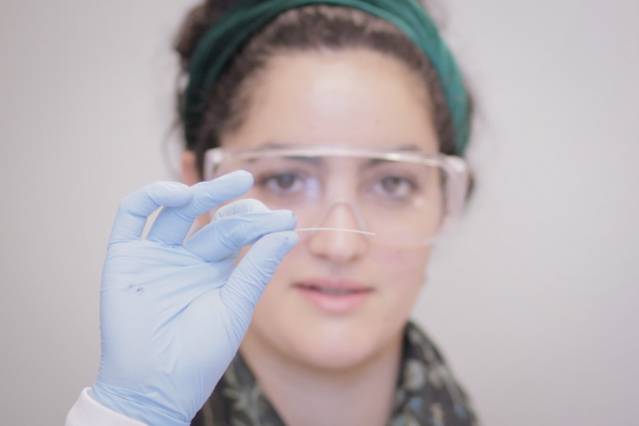Researchers at Massachusetts Institute of Technology (MIT) have created complex multimodal polymer fibers that have the ability to deliver drugs and optical signals into the brain, directly. These fibers also enable continuous monitoring of the effect of numerous inputs thorough simultaneous electrical readouts. Further, these fibers can be produced with thickness less than that of a hair’s width.
 Christina Tringides, a senior at MIT and member of the research team, holds a sample of the multifunction fiber produced using the group’s new methodology. Photo: Melanie Gonick/MIT
Christina Tringides, a senior at MIT and member of the research team, holds a sample of the multifunction fiber produced using the group’s new methodology. Photo: Melanie Gonick/MIT
The human brain is extremely complex due to its immense size and the numerous methods of simultaneous signaling. Standard neural probes have the ability to record a single signaling type, and this limits the amount of information that can be obtained from the brain at a specific point in time. This study may have found a way to get over this limitation.
Polina Anikeeva of MIT and 10 others have written this study that has been published in the journal, Nature Biotechnology. Technology similar to that used in this study has been described by the team in an earlier paper.
Anikeeva states that polymers that possess characteristics similar to that of neural tissues make up these new fibers. They allow transmission of different types of signals and they can also stay in the body for a much longer period without affecting the surrounding delicate tissues.
Multifunctional fibers communicate with the brain
MIT researchers discuss their novel implantable device that can deliver optical signals and drugs to the brain, without harming the brain tissue. Video: Melanie Gonick/MIT
We’re building neural interfaces that will interact with tissues in a more organic way than devices that have been used previously.
Anikeeva, an assistant professor of materials science and engineering
In order to achieve that, the research team utilized a new fiber-fabrication technology that was developed by Yoel Fink, an MIT professor of materials science and co-author of this paper, and his team. This technology had been developed for various applications including photonics.
The result, Anikeeva explains, is the fabrication of polymer fibers “that are soft and flexible and look more like natural nerves.” Currently, metals, glass and semiconductors are used for making devices that can be used for performing neural recording and stimulation. However, even during ordinary movement, they can damage the tissues nearby.
“It’s a big problem in neural prosthetics,” Anikeeva says. “They are so stiff, so sharp — when you take a step and the brain moves with respect to the device, you end up scrambling the tissue.”
The important part of the new technology involves making a preform of the channel arrangement within the fiber in the manner desired. The preform is a larger-scale version. The various channels in the fiber include conductive electrodes for carrying electrical signals, optical waveguides for carrying light, and hollow tubes for carrying drugs. The polymer templates can be softened by heating and then can be drawn in the form of a thin fiber. In this process, the arrangements of features in the templates are retained as designed.
The material’s cross-section reduces 200-fold with a single draw. Repetition of this process enables thinner fibers every time and may reach nanometer scale. During this process, Anikeeva says, “Features that used to be inches across are now microns.”
Anikeeva adds that the combination of different channels within a single fiber could facilitate accurate mapping of neural activity, which could not be done with single-function neural probes. This fiber may help treat neurological disorders. When light is transmitted through the optical channels it enables optogenetic neural stimulation and the embedded electrodes could be used to monitor the effects. Simultaneously, drugs could be injected through the hollow channels into the brain. The electrical signals that occur in the neurons are recorded in real time and they would help ascertain the exact effect of the drugs.
For specific tasks such as a therapeutic application or particular research, the exact suitable combination of channels can be created. “You can have a really broad palette of devices,” Anikeeva says.
A single preform that is just a couple of inches long can be drawn as a fiber stretching to hundreds of feet. However, the different materials used for the preform must be chosen so that all of them soften at the same temperature. “The fibers could ultimately be used for precision mapping of the responses of different regions of the brain or spinal cord,” Anikeeva says, “and ultimately may also lead to long-lasting devices for treatment of conditions such as Parkinson’s disease.”
John Rogers, a professor of materials science and engineering and of chemistry at the University of Illinois at Urbana-Champaign who was not involved in this research, says, “These authors describe a fascinating, diverse collection of multifunctional fibers, tailored for insertion into the brain where they can stimulate and record neural behaviors through electrical, optical, and fluidic means. The results significantly expand the toolkit of techniques that will be essential to our development of a basic understanding of brain function.”
Other MIT researchers who took part in the study were Andres Canales, Ulrich Froriep, Christina Tringides, Chi Lu, Lei Wei, Xiaoting Jia, Ryan Koppes, Jennifer Selvidge and Chong Hou. The National Science Foundation, the Center for Sensorimotor Neural Engineering, the Center for Materials Science and Engineering, the Simons Foundation, the U.S. Army Research Office through the Institute for Soldier Nanotechnologies, and the McGovern Institute for Brain Research have provided support for this project.
References